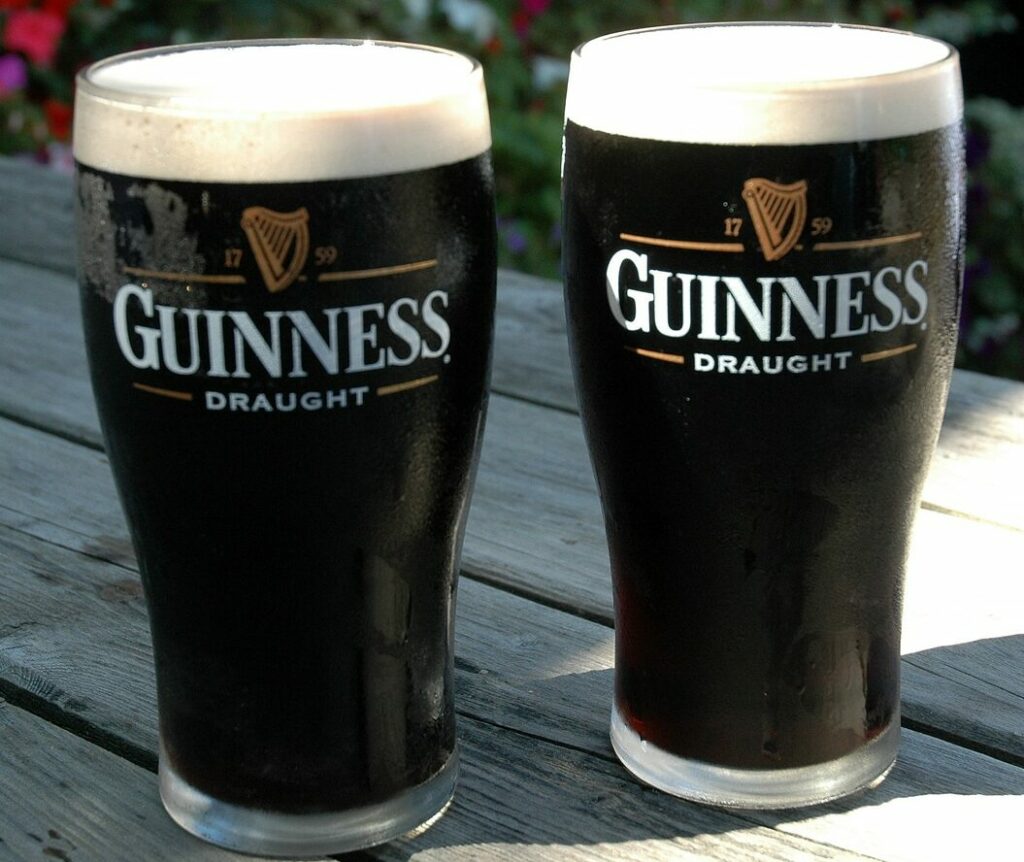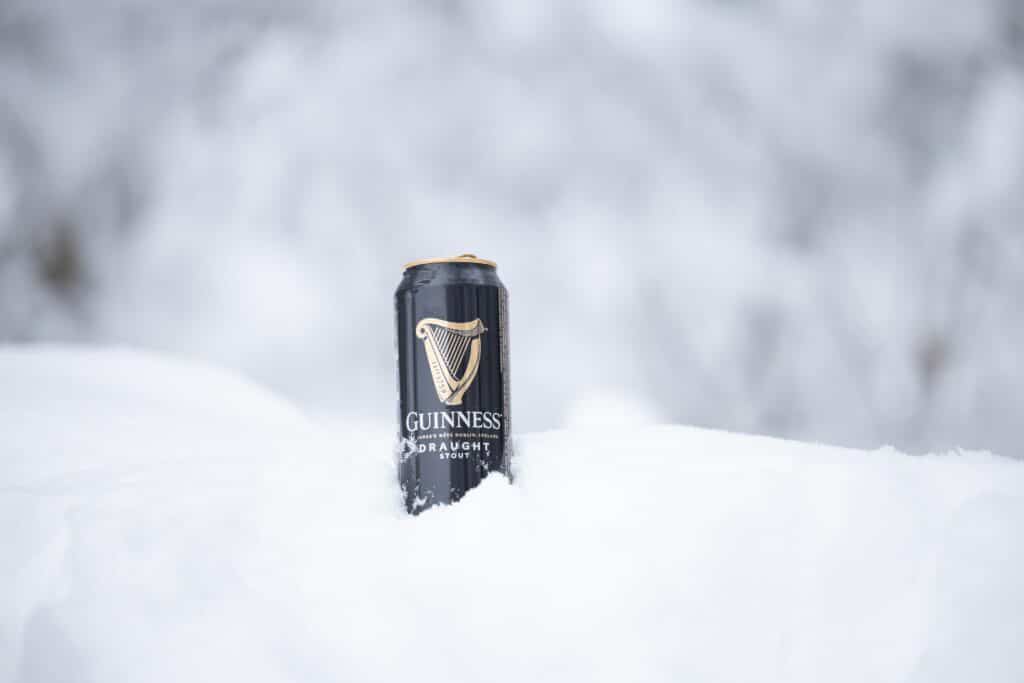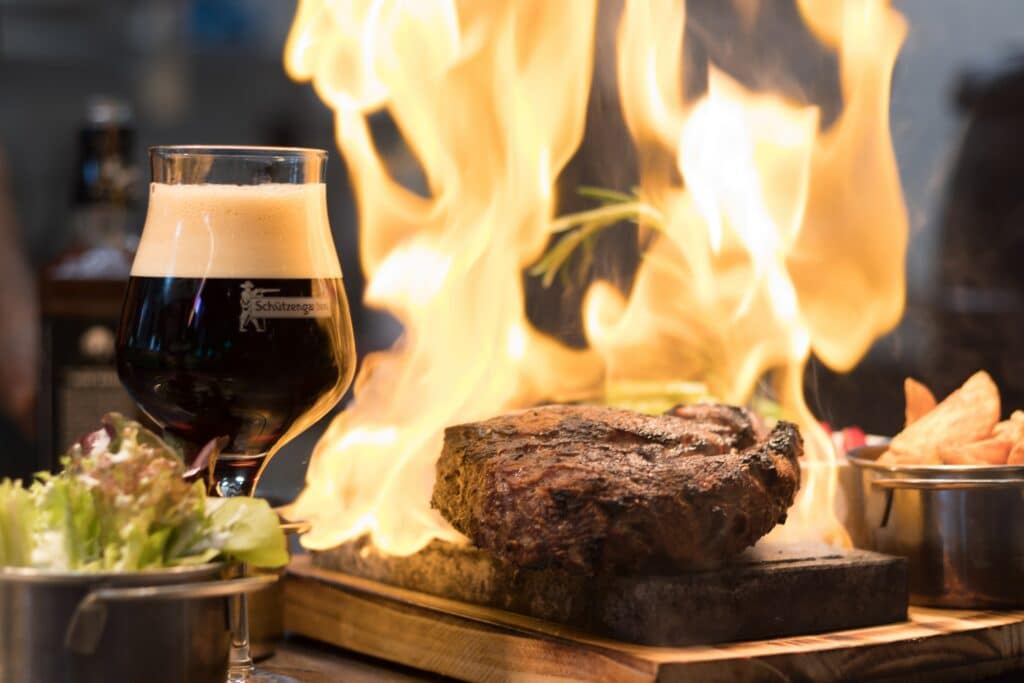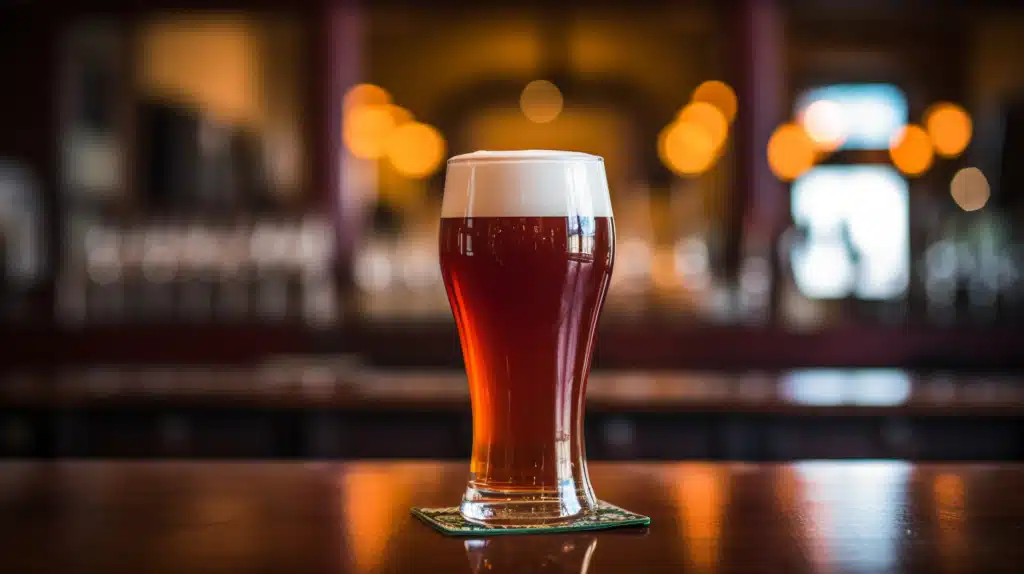Disclaimer: This post may contain affiliate links, from which I may earn a small commission at no extra cost to you. Thank you for supporting Ale Affair.
“I don’t have friends; I got family.” No, Nitro Beers are not the fuel that makes Vin Diesel’s cars faster. So, if they’re not for street racers, what are they? This article explores the fast and furious world of Nitro beers, looking at their brewing process, history, and main characteristics. I’ll even throw in a few of my favourites for you to try. So, see you at the finish line!
Discovering the Nitrogen: What Makes a Nitro Beer
Nitro Beer, short for nitrogenated beer, serves a distinctly creamy, smooth drinking experience that sets them apart. But what’s behind this extraordinary pint?
Most beers use carbon dioxide during the brewing process. Now, this is where Nitro Beers flip the script. Instead of solely relying on carbon dioxide, Nitro Beer introduces nitrogen into the equation, either partially or entirely replacing the carbon dioxide. The reason behind this swap lies in the unique properties of nitrogen.
How are they brewed?
Brewing Nitro Beers involves a process similar to traditional carbonated beers, with a critical difference in the carbonation stage. But hey, “We talkin’ or we racin’?” (There will be a few more Vin Diesel quotes; I’m sorry).
- Mashing: The brewer mixes crushed malted barley (and sometimes other grains) with hot water to create a mash. This process converts the starches in the grains into fermentable sugars.
- Lautering: The liquid part of the mash, now called wort, is separated from the grain solids.
- Boiling: The wort is boiled, and hops are added for bitterness, flavour, and aroma. The boiling process also sterilizes the wort.
- Cooling: After boiling, the wort is cooled to a temperature suitable for adding yeast for fermentation.
- Fermentation: Yeast is added to the cooled wort, initiating the fermentation process. Yeast consumes the sugars, producing alcohol and carbon dioxide. This stage is essentially the same for both Nitro and carbonated beers.
- Conditioning: The beer matures, allowing flavours to develop. This process can occur in the same vessel as fermentation or after the beer has been transferred to a new container.
- Carbonation (The Key Difference): Traditional beers are carbonated by introducing carbon dioxide. This can be done by force carbonating the beer under pressure in a sealed keg or tank or through natural carbonation in the bottle or cask by adding a small amount of sugar to provoke secondary fermentation.
Nitro Beers are often force-carbonated with a mix of about 70% nitrogen and 30% carbon dioxide. When poured, this specific mix helps achieve the desired creamy mouthfeel and the characteristic cascading effect.
Interestingly, Nitro Beers require a unique tap system for serving. A restrictor plate in the tap forces the beer through small holes, creating the fine, creamy bubbles associated with Nitro beer. This process also contributes to the beer’s cascading effect as it settles in the glass.
Carbonation vs Nitrogenation
Why has Nitro beer got to be different? Well, how different is the nitrogenation process? The key differences between these two processes of introducing gas into the beer are, obviously, the type of gas used (carbon dioxide for carbonation, nitrogen for nitrogenation) and the outcomes they produce in the beer.
Let’s break it down—warning: this may feel like a chemistry lesson.
Carbonation
- Gas Used: Carbon Dioxide (CO2)
- Process: This can be natural, occurring during fermentation as the yeast converts sugars into alcohol and CO2, or artificial, by directly infusing CO2 into the beer under pressure.
- Effect on Beer:
- Mouthfeel: Adds a sharp, prickly texture due to the bigger bubbles created by CO2.
- Appearance: Produces larger, less stable bubbles, leading to a quickly dissipating head.
- Common Use: The standard method for most beer styles, from lagers and ales to IPAs and stouts.
Nitrogenation
- Gas Used: Nitrogen (N2)
- Process: Nitrogen is artificially infused into the beer using a mix of nitrogen and a small amount of CO2 under high pressure. Special equipment is required for both infusion and serving.
- Effect on Beer:
- Mouthfeel: Creates a creamy, smooth texture due to the smaller, finer bubbles produced by nitrogen.
- Appearance: Known for the mesmerizing cascade effect when poured, resulting in a dense, creamy head that is more stable and long-lasting than CO2-carbonated beers.
- Common Use: It is popular in certain beer styles that benefit from a creamier mouthfeel and smoother taste, such as stouts (e.g., Guinness) and porters, but it is increasingly used in various styles.
Key Differences
Nitrogen is far less soluble in liquid than carbon dioxide, creating smaller bubbles and a creamier texture. This low solubility also requires nitrogenated beers to be served under higher pressure to maintain their unique characteristics.
While carbonation sharpens and accentuates flavours, nitrogenation softens and smooths them, offering a distinctly different drinking experience.
The History of the Nitro Beer
Nitro beer is relatively recent in the long history of brewing. Its development is closely associated with the quest to achieve a smoother texture and a unique presentation in beer. Let’s start from the beginning.
Origins
The origins of Nitro beer are most famously linked to Guinness, the iconic Irish brewery. While using nitrogen in beer was not a new concept, Guinness pioneered the specific application that led to what we now recognise as Nitro beer in the 1950s and 1960s.

Guinness and the Widget
In 1959, Guinness introduced its Draught Guinness in kegs, a significant innovation. However, the real breakthrough came in 1969 with the introduction of nitrogenation to replace or supplement carbon dioxide in beer. This revolutionary move changed the texture and serving experience of beer.
Guinness aimed to replicate the draft experience in a can, leading to the development of the “widget” in the 1980s—a small plastic device in cans (and later bottles) that releases nitrogen when the can is opened, creating the beer’s signature creamy head (don’t like that phrase) and smooth texture.
So, if you’ve ever wondered why there’s a ball in your Guinness can, the widget’s nitrogenated beer fires the rest of the beer, giving it a velvety texture.
The Widget’s Impact
The introduction of the widget was a pivotal moment in the history of Nitro Beers. It allowed for the widespread distribution of nitrogenated beer in a format that preserved the unique qualities of a Nitro pour outside of the pub. This innovation made Nitro Beers accessible to a broader audience and inspired other breweries to explore nitrogenation.
Modern Nitro Beers: Expansion and Experimentation
Following Guinness’s success, other breweries began experimenting with nitrogenation, extending beyond traditional stouts to include ales, lagers, and various craft styles. Nitro Beers’ distinctive mouthfeel and visual appeal have made them a popular choice among brewers looking to differentiate their products and among consumers seeking a unique beer-drinking experience.
Today, Nitro Beers are found globally, with many breweries offering their take on nitrogenated brews. While stouts remain the most common style for nitrogenation due to their complementary flavour profiles and textures, the technique has been applied to nearly every beer style imaginable, from IPAs to porters to amber ales.
The rise of craft brewing has particularly embraced nitrogenation, pushing the boundaries of what Nitro beer can be.
The Characteristics of a Nitro Beer: Why Do They Taste Different?
So, we have explored what makes a Nitro Beer. Let’s not run through its characteristics. Nitrogen gas imparts unique characteristics that give Nitro Beers their distinct taste and sensory experience. Now, “I’m a boy who appreciates a good body, regardless of the make,” but let’s explore the main attributes under the hood.
Creamier and Smoother Texture
Nitrogen bubbles are smaller and less soluble than CO2 bubbles, creating a denser, creamier foam head when the beer is poured. This foam head contributes to a silky, smooth mouthfeel that’s noticeably different from carbonated beers’ sharper, more prickly sensation.
The smooth texture can make the beer feel richer and subtly alter the flavour profile, often rounding out the harsher edges of bitterness or acidity.

Reduced Carbonation
Because nitrogen is less soluble in liquid than carbon dioxide, Nitro Beers have a lower level of carbonation. This means fewer large bubbles and less fizz. This allows for a softer, more subtle flavour profile to emerge, highlighting malt sweetness or the beer’s creamy aspects without the acidic bite that carbonation can bring.
Aesthetic and Sensory Appeal
The pour of a Nitro beer, with its cascading bubbles and thick, stable head, adds to its charm and suspense and potentially influences the drinker’s perception of taste. When I see a good pint of Guinness, I know I’m in for a treat!
Muted Flavours
Lower carbonation and the presence of nitrogen can silence some of the more pronounced flavours in carbonated beers. This is particularly true for hop bitterness and certain spice notes, which may be less intense in Nitro Beers. This means Nitro Beers often have a more balanced, mellow flavour profile, with no single taste characteristic dominating.
Temperature and Serving Style
Nitro Beers are often served slightly warmer than highly carbonated beers, which can further influence how their flavours are perceived.
Warmer serving temperatures can enhance the perception of specific flavours, such as caramel, chocolate, and coffee, making these notes more prominent in Nitro Beers.
Can Any Beer Go on Nitro?
Almost any beer can technically be nitrogenated, but should you? This depends on the beer’s style and desired sensory effects. Since nitrogen creates a creamy mouthfeel and smooth texture, this traditionally complements stouts and porters best due to their rich, roasted flavours.
However, the trend of experimenting with Nitro has expanded to include various styles, such as IPAs and even sour beers, though with mixed results.
9 Popular Nitro Beers to Try
I bet you are just dying to try a Nitro beer now. Lucky for you, I have compiled the best Nitro Beers to try. If you don’t like them, don’t worry, I won’t tell because “I never narc’d on nobody! I never narc’d on nobody!”
- Guinness: Do we even need to try to sell this? After all, it’s the most popular beer in the world!
- Left Hand Brewing Nitro Milk Stout: Known for its velvety smooth mouthfeel and chocolatey sweetness, this Nitro stout has become a staple in the American craft beer scene.
- Samuel Adams Nitro White Ale: A play on a classic Belgian style, this Nitro ale is refreshing and creamy, with hints of orange and spice that pop under the Nitro smoothness.
- Young’s Double Chocolate Stout Nitro: Imagine a rich chocolate cake transformed into a beer – that’s what you get with this indulgent, Nitro-charged stout.
- Oskar Blues Old Chub Nitro Scotch Ale: This rich, malty beer boasts a silky Nitro mouthfeel and flavours of cocoa and coffee, making it a hearty brew perfect for colder months.
- Murphy’s Irish Stout: A close competitor to Guinness, Murphy’s offers a softer, sweeter version of a Nitro stout with notes of chocolate and coffee.
- Boddingtons Pub Ale: This English Nitro Beer is a refreshing, smooth beer renowned for its golden colour, full-bodied flavour and malty, moreish taste.
- Founders Nitro Oatmeal Stout: Another great example of a Nitro stout brewed with flaked oats, chocolate malt, roasted barley and Nugget hops.
- Deschutes Brewery’s Nitro Obsidian Stout: A stout as black as the nearby volcanic flow from which it is named, with intense layers of espresso and chocolate.

Sampling these beers gives a taste of the range and versatility of Nitro Beers. The subtle smoothness added by nitrogen allows different flavours to shine, making each Nitro beer a unique experience. Whether you’re a stout lover or prefer ales, there’s a Nitro beer out there for you.
Summary
Nitro Beers offer a unique twist in the beer world with their creamy texture and visually appealing pour. They’re differentiated from other beers through nitrogenation, replacing or supplementing carbon dioxide with nitrogen. Guinness has a significant role in the history of Nitro beer, being the pioneer in its invention. As the craft beer industry expands, more breweries are experimenting with nitrogenation, contributing to the growing list of Nitro Beers available. Why not try the ones listed above? So, ’til I see you again!
FAQs
Is There Caffeine in Nitro Beer?
Nitro Beers typically do not contain caffeine unless specifically brewed to include it, such as in the case of a coffee nitro beer.
Does Nitro Beer Get You Drunk Faster?
Nitro beer does not inherently get you drunk faster than other beer types based solely on its nitrogenation. The alcohol content of a beer is what determines how quickly it might affect your level of intoxication.
Are Nitro Drinks Bad For You?
Nitro drinks, including Nitro Beers and nitro cold brew coffees, are generally considered safe for most people when consumed in moderation.
Share Now!
Raise a glass to knowledge! Each article you share pours a little more wisdom into the world, frothing with ideas and bubbling with insights.




